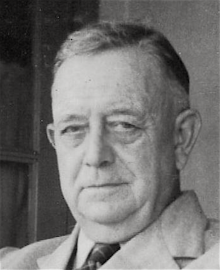
Claude Batley was born in Ipswich, Suffolk, England in 1879 and was articled to George William Leighton (1868?-1940) in Ipswich from 1897 to 1900. He also attended the South Kensington Museum School in London. He worked as an assistant to George Weymouth (1845-1923) from 1901 to 1903 and after passing his qualifying exam in 1904, commenced independent practice as an architect in Kettering, Northamptonshire that year. He was for a period in partnership with Hugo Ritchie Bird (1879?-1958).
In 1913 Batley emigrated to India where he was in partnership with Thomas Sedgwick Gregson and H. Foster King as Gregson, Batley & King in Bombay [now Mumbai] until at least the late 1930s. He was also Professor of Architecture at the Sir J. J. School of Art [Government School of Art] in Bombay [Mumbai] from 1924 to 1943.
Batley was elected an Associate of the Royal Institute of British Architects (ARIBA) in 1904. He was a member of the Indian Institute of Architects and twice its President. He was also Chairman of the All India Board of Architectural and Regional Planning Studies. He was the author of The Design Development of Indian Architecture (1934).
Batley died in Bombay [Mumbai] on 20 March 1956
Notable among architectural work by Batley were the Bombay Gymkhana building (1917) in Bombay [Mumbai]; Bombay Central Railway Station [now Mumbai Central Terminus] (1920s); Ahmedabad Town Hall (1930s); Sheth Maneklal Jethabhai Pustakalaya public library (1938) in Ellisbridge, Ahmedabad; Vijali Ghar (1930s), an office building in Ahmedabad; and Jinnah House (1936) in Bombay [Mumbai].
Directory of British Architects 1834-1914. Compiled by Antonia Brodie, et al. Volume 1: A-K. London; New York: British Architectural Library, Royal Institute of British Architects/Continuum, 2001
'Obituary'. The Builder vol. 190, 6 April 1956 p. 262
'Obituary'. RIBA Journal vol. 63, September 1956 p.479